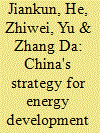|
|
|
Sort Order |
|
|
|
Items / Page
|
|
|
|
|
|
|
| Srl | Item |
| 1 |
ID:
186466


|
|
|
|
|
| Summary/Abstract |
This study takes the CO2 emissions from the energy consumption of 30 provinces in China as the research object. We predict and analyze a significant phenomenon involving the total CO2 emissions of inter-provincial energy consumption from the east to the west. On the basis of three CO2 emission reduction scenarios (Scenario 1: Baseline Scenario (10%–20% emission reduction target), Scenario 2: 2 °C Path Scenario (50%–60% emission reduction target), and Scenario 3: 1.5 °C Path Scenario (75%–85% emission reduction target)), a regional synergy scenario is proposed for the first time in this article. That is, the government develops multi-field CO2 regional synergistic emission reduction (RSER) based on regional industry coordination by rationally guiding the implementation of the “enclave economy.” Moreover, we compare and analyze the different carbon emissions of the multiple “Carbon Neutrality” targets in 2050 under multiple scenarios. The results reveal that compared with scenario 1, scenario 2, and scenario 3, the regional synergy scenario can achieve 18.4%, 58.4%, and 83.4% reduction, respectively, compared with the current situation, which is significantly higher than the effect of the emission reduction targets set based on the average threshold values (15%, 55%, and 80%) of the above scenarios.
|
|
|
|
|
|
|
|
|
|
|
|
|
|
|
|
| 2 |
ID:
116907


|
|
|
|
|
| Publication |
2012.
|
| Summary/Abstract |
In recent years, China has made great efforts in energy saving and carbon emission reduction by pushing forward domestic sustainable development along with global climate change mitigation. The efforts have paid off with a dramatic decrease in carbon intensity. Nevertheless, China is still confronted with tough challenges in emission control due to the fast pace of industrialization, large total historical emission and high growth rate of emissions. Therefore, China should give priority to energy saving by improving energy efficiency and sectoral structure adjustment and upgrade, and develop sustainable and renewable energy to optimize energy mix and its carbon content. China should continue to regard significant reduction of energy intensity and carbon intensity as the main objective in the near future, strive to achieve peak emissions around 2030, and realize a relatively sharp emissions reduction by 2050 in order to address climate change to meet the goal of making the warming less than 2°. During the 12th Five Year Plan (FYP), China will further strengthen measures to control the amount of energy consumption, establish a statistics, accounting and evaluation system of carbon emissions, and promote a market-based carbon emissions trading mechanism to facilitate the low-carbon transformation of China's economy.
|
|
|
|
|
|
|
|
|
|
|
|
|
|
|
|
| 3 |
ID:
150652


|
|
|
|
|
| Summary/Abstract |
Participation in demand response (DR) may affect a consumer's electric consumption pattern through consumption load curtailment, a shift in the consumption timing or increasing the utilization of distributed generation (DG). This paper attempts to provide empirical evidence of DR's effect on DG adoption by household consumers. By using the original Internet survey data of 5442 household respondents in Japan conducted in January 2015, we focus on the effect of the time-of-use (TOU) tariff on the purchasing intention of photovoltaic systems (PV). The empirical results show the following: 1) current TOU plan users have stronger PV purchase intentions than the other plan users, 2) respondents who are familiar with the DR program have relatively higher purchase intentions compared with their counterparts, and 3) when the respondents are requested to assume participation in the virtual TOU plan designed for the survey, which resembles plans currently available through major companies, 1.2% of the households have decided to purchase PV. In addition, we provide calculations of TOU's impacts on the official PV adoption and emissions reduction targets, and discuss policy recommendations to increase recognitions and participations in TOU programs.
|
|
|
|
|
|
|
|
|
|
|
|
|
|
|
|
| 4 |
ID:
133312


|
|
|
|
|
| Publication |
2014.
|
| Summary/Abstract |
We evaluate the contribution of technological change in reducing CO2 emissions in the Italian pulp and paper industry during the first and second phases of application of the European Union Emission Trading System (EU-ETS). We decompose the variation in emission and emission intensity into three different types of effects: a composition effect, a technique effect and a scale effect. The composition effect measures the change in emissions and emissions intensity due to a shift in production towards products that cause less emissions. The technique effect measures the change per each type of product, thereby accounting for technology improvements in the production of each type of good produced. The scale effect singles out the reduction in total emission due to an overall reduction in output. We show that the first phase of the application of EU-ETS has led to a reduction in both emissions and emission intensity due to the composition effect. The technological change has had a limited negative impact on emissions in the first phase, while in the second phase there has been limited technology improvement in the industry. However, the figures of the scale effect show that the larger reduction in emission is due to the overall decrease in output.
|
|
|
|
|
|
|
|
|
|
|
|
|
|
|
|
| 5 |
ID:
181776


|
|
|
|
|
| Summary/Abstract |
The Covenant of Mayors (CoM) is an initiative that voluntarily engages municipalities to devise local policies to reduce CO2 emissions and energy consumption. The progress of the CoM in Malta and Gozo is evaluated; evidence suggests that signatories have not sufficiently fulfilled their obligations to the initiative and there has been little contribution of the CoM to the local reduction of CO2 emissions and energy consumption for the 2020 set of targets for Malta. Overall, it was noted that local councils have not had sufficient autonomy, resources and external support to enable their successful participation in the initiative. The barriers experienced by Maltese signatories have been identified as ineffective communication and lack of resident engagement. With the large potential for local governments to contribute towards climate change mitigation and adaptation, certain policy recommendations are made to improve the effectiveness of local governments’ involvement in climate policies and initiatives. These measures focus on the financing of local councils, organisational and accountability procedures, prioritisation of climate action, outreach and involvement of the general public, and continued awareness raising of climate issues.
|
|
|
|
|
|
|
|
|
|
|
|
|
|
|
|
| 6 |
ID:
124681


|
|
|
|
|
| Publication |
2013.
|
| Summary/Abstract |
In this paper we evaluate two approaches for estimating CO2 emission reduction from electricity savings: one based on average CO2 intensities of electricity generation and another that relies on marginal CO2 intensities.
It is found that the average CO2 intensity approach has a significant shortcoming when it comes to scenario-based approaches for CO2 emission reduction. This shortcoming lies in the chicken-egg problem created, where larger future electricity savings are actually big enough to change the CO2 intensity in such a way that it cannot be used anymore to estimate the CO2 emission reduction. We show that in these cases the marginal approach is preferred. To correctly apply this approach, it is important to determine the CO2 intensity of the future power mix which will not be built in order to avoid under or overestimation of the CO2 savings calculated. We propose a seven-step approach which can be used in scenario-based potential studies as guidance for estimating the CO2 emission reductions from not only electricity savings but also renewable electricity and mitigation options that consume electricity such as electric cars and heat pumps. Using our approach would avoid a disconnection of the CO2 reduction potential with the underlying reference scenario.
|
|
|
|
|
|
|
|
|
|
|
|
|
|
|
|
| 7 |
ID:
103337


|
|
|
|
|
| Publication |
2011.
|
| Summary/Abstract |
This paper examines the impacts of CO2 emission reduction target and carbon tax on future technologies selection and energy use in Bangladesh power sector during 2005-2035. The analyses are based on a long-term energy system model of Bangladesh using the MARKAL framework. The analysis shows that Bangladesh will not be able to meet the future energy demand without importing energy. However, alternative policies on CO2 emission constraints reduce the burden of imported fuel, improve energy security and reduce environmental impacts. The results show that the introduction of the CO2 emission reduction targets and carbon taxes directly affect the shift of technologies from high carbon content fossil-based to low carbon content fossil-based and clean renewable energy-based technologies compared to the base scenario. With the cumulative CO2 emission reduction target of 10-20% and carbon tax of 2500 Taka/ton, the cumulative net energy imports during 2005-2035 would be reduced in the range of 39-65% and 37%, respectively, compared to the base scenario emission level. The total primary energy requirement would be reduced in the range of 4.5-22.3% in the CO2 emission reduction targets and carbon tax 2500 Taka/ton scenarios and the primary energy supply system would be diversified compared to the base scenario.
|
|
|
|
|
|
|
|
|
|
|
|
|
|
|
|
| 8 |
ID:
110415


|
|
|
|
|
| Publication |
2011.
|
| Summary/Abstract |
In order to reduce energy-related CO2 emissions different options have been considered: energy efficiency improvements, structural changes to low carbon or zero carbon fuel/technologies, carbon sequestration, and reduction in energy-service demands (useful energy). While efficiency and technology options have been extensively studied within the context of climate change mitigation, this paper addresses the possible role of price-related energy-service demand reduction. For this analysis, the elastic demand version of the TIAM-UCL global energy system model is used in combination with decomposition analysis. The results of the CO2 emission decomposition indicate that a reduction in energy-service demand can play a limited role, contributing around 5% to global emission reduction in the 21st century. A look at the sectoral level reveals that the demand reduction can play a greater role in selected sectors like transport contributing around 16% at a global level. The societal welfare loss is found to be high when the price elasticity of demand is low.
|
|
|
|
|
|
|
|
|
|
|
|
|
|
|
|
|
|
|
|
|